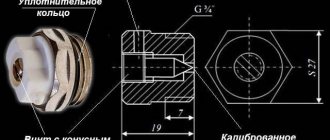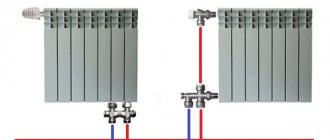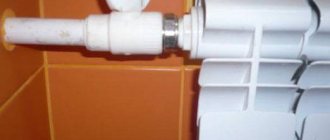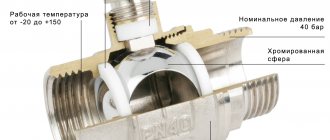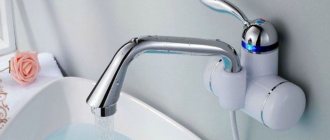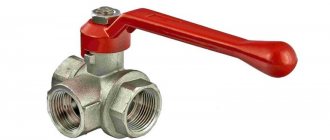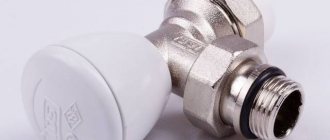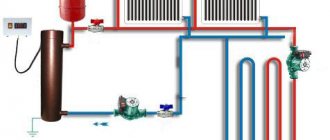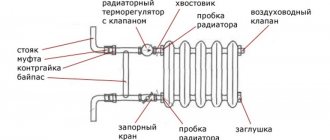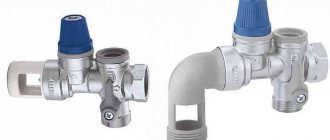Dissolved air enters the heating system along with the coolant. Accumulating in significant quantities, oxygen creates plugs that prevent normal fluid circulation. This reduces the quality of heating of the building. To eliminate airing of the system, a Mayevsky crane was designed. The principle of operation is simple and clear, so such a device is installed everywhere - be it a multi-storey building or a modest cottage.
The Mayevsky crane helps get rid of air jams in the heating network
Purpose of the Mayevsky crane
Air is lighter than water, so it accumulates at the peak points of the space heating system and radiators. This happens for several reasons:
- pipes do not fill with water quickly enough;
- the fed system was partially empty;
- There is a lot of dissolved oxygen in water.
Sometimes the accumulation of air provokes a special design of the heating system, when in certain areas loops of pipes are formed, turned upward.
In 1931, the State Planning Committee decided that during downstream installations, ordinary taps should be installed to remove air from systems. But through them, residents of houses not only eliminated air locks, but often drained hot water, which in this case acts as a coolant, and then used it for household needs - for example, to wash the floors. This was unacceptable from the standpoint of sanitation and the technology of central heating of buildings. Therefore, Mayevsky taps began to be installed on radiators, which significantly complicated the task of inappropriate use of coolant.
Installing a tap prevents water from being used for other purposes
Mayevsky crane: photo of appearance
Whatever the technical design of the Mayevsky valve, the operating principle of this device always corresponds to its direct technological purpose and the regulations of the industry standard - this is a valve for bleeding air STD 7073V (according to TU 36-710-82) from heat supply systems for industrial and domestic use.
Appearance of the classic Mayevsky crane.
Structurally, it is designed as a needle-type air shut-off valve (hence the second name) in the form of a combined radiator plug with a built-in mechanism for bleeding air. Since the STD 7073B standard regulates design dimensions, the air valve for radiators (aka Mayevsky) has an outer mounting diameter of half an inch (1/2″), three-quarters of an inch (3/4″), one inch (1″), etc. d. The valve sizes with a nominal diameter (DN) of 15, 20 and 25 mm allow it to be used not only in radiators, but also in various components of the heating system. Technical characteristics include such parameters as operating pressure (Pu) - 10 atm (1 MPa) and operating temperature - up to 120 degrees Celsius.
How the Mayevsky crane works
The device was developed in 1933 by an engineer from Leningrad, Cheslav Bronislavovich Mayevsky. Officially it is called a radiator needle air valve.
According to some historical data, the crane of Minsk resident S.A. Roev first appeared. It consisted of two parts separated by a gasket. The devices were tested in 1932. A year later, Mayevsky improved this design, improving the sealing of parts. In a more modern interpretation, the engineer connected the parts using the “cone-to-cone” method.
The crane consists of the following components:
- frame;
- conical head screw;
- turning part;
- inlet and outlet channels for air.
Design of the device
The air vent device drives the locking screw. The latter is controlled with a screwdriver or manually, which depends on the specific model. In the modern version, a special key is already installed on the tap, so using the device has become easier.
Advantages of installing a Mayevsky crane:
- increasing the efficiency of the heating network;
- simplification of radiator maintenance;
- affordable cost of the unit itself.
But such a crane, despite the listed advantages, also has a drawback. Since the quality of the coolant often leaves much to be desired, blockages often occur in the tap during operation.
Depending on the design, there are three types of crane:
- radiator - intended for heating devices;
- traditional - installed everywhere, equipped with external thread;
- complete - is a ball valve with KM.
Sectional drawing of a faucet
Depending on the method of unscrewing, there are the following devices:
- for a screwdriver;
- turnkey four- or hexagonal;
- with a handle, which does not require a tool.
Various materials and their combinations are also used for manufacturing. There are CMs:
- steel;
- brass;
- cast iron;
- stainless steel;
- plastic.
Most often, the assembly is made from brass, which is resistant to corrosion, which threatens the materials due to unfavorable operating conditions. Often, unscrupulous sellers pass off cheap silumian as brass. But this material is unreliable, products made from it quickly fail.
Attention! Children love to play with various objects. Therefore, it is better to install a tap in their room that can be opened with a screwdriver. If the baby opens the tap on his own, he will get burns.
In children's rooms, it is recommended to install device models “under a screwdriver”
Automatic KM
Automatic CMs are convenient in private homes with individual heating, as they eliminate air locks and regulate the pressure independently. Inside this unit there is a chamber equipped with a float inside. This, in turn, is connected to a needle valve located at the top of the assembly.
When the air gap exceeds the set limit, the valve opens for a while, allowing air to leave the system. Then, due to the action of the float, it returns to its original position again, preventing water from flowing out.
Automatic crane model
The main advantage of AKM is that there is no need to place a container to remove air trapped inside the pipes, since water does not flow out. The tap is automatically blocked as soon as the coolant level rises. However, automatic models are more expensive than mechanical ones.
Air vents are:
- straight;
- corner;
- radiator.
Video - Mayevsky crane: what it is and how it works
Mayevsky crane in pneumatic systems
A technical feature of the Mayevsky crane is its design uniqueness. It can also be used to remove not only air, but also liquid, namely from pneumatic systems with high air pressure. Typically, the compressed air entering the system from the compressor contains an excess amount of water vapor. Technologically, excess moisture is removed by special freezing devices and various filters.
Plastic key for the Mayevsky valve.
Over a long period of operation, a significant amount of water can accumulate in stationary (pipe) lines. It accumulates in the lowest zones of the pneumatic lines and is sprayed throughout the entire circuit. It is very undesirable for water to enter pneumatic devices and equipment powered by compressed air. In these cases, the Mayevsky crane comes to the rescue. Only in this case is it mounted at the lowest point of the circuit and the bleeding process begins with the release of accumulated liquid (water) and ends with the release of clean air. Then the tap closes and the system again becomes hermetically closed.
Thus, it became clear how the Mayevsky crane works. Its main function is to remove accumulated air from the heating system, which plays a big role in efficiency and economy. This has a real impact on saving money during operation. Market availability, the simple design of the valve allows you to independently and without the involvement of plumbing specialists not only carry out the operation of bleeding air from the heating system circuit, but also install or replace the valve itself. Neither operation in itself involves large financial and physical costs and, most importantly, time.
Where to install the device?
The device is installed at the highest points of the premises network. However, in addition, the installation diagram of the heating network is taken into account.
The vertical method of supplying coolant requires that each radiator located on the top floor, where there is a lower supply with a return line, be equipped with a KM.
Air valves are also needed everywhere on devices in which the supply line is completely or partially below the level of the upper connection axis. Then the natural elimination of the oxygen plug becomes more difficult. In the horizontal version of the circuit, the CM is placed on each heating radiator.
Placement of Mayevsky air vent valves for both scheme options
Air valves are also installed in areas where there are bends in the pipeline. So, for example, when a pipe bends sharply upward and then descends down a short section, a pocket is formed. Airing will constantly occur in this area. The crane is installed here at the top point of the site.
The “warm floor” system in most cases also requires the installation of this equipment. Air release is most effective on the collector group, which rises above the floor level.
“Heated floor” systems are rapidly gaining popularity among owners of private country houses and city apartments. In a special article we will tell you whether it is possible to connect a “warm floor” from heating.
Mayevsky taps are also installed in the towel dryer in the bathroom. This is necessary when airing occurs regularly in the system. The manufacturer provides a hole for the valve in heated towel rails connected from below. When connecting laterally, this section of the pipe is slightly modified. Then a tee with the required thread parameters is implanted into the supply zone. Install the device, directing the outlet away from the wall.
It is important! If air constantly accumulates in the pipes, then during the next repair it is worth purchasing models of towels that are already equipped with a Mayevsky tap.
Towels with installed air vent
Design and principle of operation
In order for the heating system to work properly, it is necessary to constantly monitor the water level in the pipes and its circulation. The liquid is a coolant. If an air blockage occurs, the movement of water either stops or occurs at a lower speed. Due to this, heat transfer deteriorates and the efficiency of the heat pipe decreases.
Mayevsky cranes are designed for purposes such as eliminating air jams in the system. For good coolant circulation, it is necessary to monitor the pressure in the pipes and the volume of air in the system.
Air, accumulating in large quantities, stops the movement of water. Heat stops supplying to the room. Needle valves are installed on pipes at joints and at complex turning areas in the structure.
What to look for when buying an air vent valve?
Heating systems are susceptible to water hammer. This happens rarely, but the possibility exists. Therefore, it is better to choose models with a safety valve that is sensitive to pressure changes. When the indicator reaches critical levels, the valve opens and water leaves the heating circuit.
Reference. Water hammer is a pressure difference that is caused by a sharp change in the speed of the coolant. This phenomenon leads to the formation of cracks, ruptures of pipes and radiators, as a result of which the coolant flows out of the system and floods the premises. PVC pipes are most often damaged.
It is better to choose products with rubber or silicone gaskets. There are also paronite gaskets, but they have proven to be worse. Additionally, the thread can be strengthened with linen tow or fum tape.
Water hammer in the heating system
When choosing a faucet, take into account its location and the design of the heating system itself.
Manual models of cranes are universal. When purchasing them, you must take into account the distance from the pipe on which the valve is installed to the wall. The distance is left such that the tool can be used, especially if this requires a screwdriver or pliers.
Automatic machines are not very suitable for centralized heating systems. There, the purity of the coolant raises questions, so the unit often gets clogged. Such models are not very suitable for cast iron radiators either. In the latter case, manual models in a brass case have proven themselves better. They can also be used in steam heating systems.
But AKMs are convenient in tight spaces and places with difficult access. They are also used in underfloor heating systems, since it is difficult to detect the formation of an air lock.
The Mayevsky tap will not interfere with the “warm floor” water system
When purchasing, pay attention to the thread parameters. You should also find out the type of socket on the radiator. For sale, manufacturers offer KM models equipped with a handle with a side outlet, which are more convenient than those located in the traditional way.
Also, when choosing a node, take into account the following characteristics:
- permissible pressure;
- working temperature.
What is a Mayevsky crane: operating principle and technical characteristics
A huge number of closed hydraulic systems used in high-tech industries (automotive, heating, mechanical engineering, etc.) use technology for removing gaseous substances (air) from the working circuit, which reduce the efficiency of their operation. This is especially true for heating systems.
The prototype of the modern Mayevsky valve is a saddle-type water tap.
The Mayevsky valve functions in the same way as a conventional shut-off type valve works - it is the opening/closing of a hermetic connection from an area of a gaseous or hydraulic medium with increased pressure to an area of an environment with normal physical conditions. The historical prototype of modern Mayevsky valve designs was the most common saddle-type water tap.
However, the uncontrolled intake of technical water from heating systems using conventional water taps required a special design that made it difficult or completely eliminated the loss of water from heating networks. An advanced solution to this problem was the Mayevsky crane, which has undergone many improvements in connection with the development of engineering thought.
Step-by-step instructions for installing KM into the system
At the first stage, preparatory work is carried out. It is advisable to carry out the installation in the warm season, when it is possible to remove coolant from the heating system. Often in old radiators there is no special hole for the CM, so it must be drilled.
- At the first stage, the pipes are removed.
- Remove the radiator from the hooks and completely drain the water.
- On the side opposite from the pipe entrance, a hole is drilled in the top plug, the diameter of which corresponds to the purchased CM.
- The threads are cut inside according to the one used on the KM. It should be taken into account that the tap has a right-hand thread, therefore, the plug has a left-hand thread. Another option is to replace the entire plug at once.
- Then install the tap, as indicated in the instructions for the device.
- The battery is returned to its place.
- At the last stage, the pipeline is connected.
For cast iron batteries, factories produce ready-made plugs for air vent valves.
The outlet hole of the valve is directed slightly downward. This makes it easier to collect the water that should flow from the tap.
When installing the device on heating pipes made of plastic, a fitting will be required.
Attention! Valves with manual control are usually installed horizontally, automatic valves are installed vertically. The correct installation must be clarified in the instructions.
Signs of system blockage
Video - Equipping a heated towel rail with an air vent tap
Features of using and adjusting the Mayevsky crane
Let's consider the option when the system is installed and assembled, but Mayevsky taps are not mounted on the radiators. Then you can do it yourself. To do this, you need to unscrew the plugs on the opposite side of the working fluid inlet into the radiator and screw in the selected valves in their place.
Mayevsky tap in the radiator heating system
Helpful advice! Regardless of the presence of a pressure seal on the threaded part of the valve body, it would be advisable to use FUM sealing tape or tow on the threads for better sealing.
How the Mayevsky crane works
Adjustment of the outlet of Mayevsky's radiator taps must be done so that it is directed in the opposite direction from the wall and preferably with a downward slope.
As for the installation of the Mayevsky tap on heated towel rails, it must be placed in a strictly vertical position using a special tee. Using the latter allows you to convert the working axis of the mounted crane from vertical to horizontal. This preferred technological location makes it possible to fulfill the requirement of the instructions: the bleed hole should be directed in the opposite direction from the wall and have a slope towards the floor.
An important issue is the use of the Mayevsky tap for cast iron radiators. Their plugs do not have mounting holes for standard valves. However, many craftsmen have found a way to install valves for bleeding air through the operation of drilling and threading in the body of a cast iron plug. But as practice shows, such “handicrafts” can lead to thread failure during water hammer phenomena, when the coolant pressure can increase tens of times. The way out of this situation is to install plugs for cast iron radiators of automatic air vents adapted to the mounting dimensions. Moreover, they are not afraid of clogging.
Do-it-yourself installation of the Mayevsky valve
It should be added to the above that in the case when the coolant may contain solid particles of debris (scale, welding flux, tow threads, paint, etc.), then it is advisable to install a standard mechanical filter for water supply in front of the tap.
Mayevsky valve: how to use
Let's look at how to use the Mayevsky tap, or more simply: how to bleed the air? The Mayevsky tap provides a fairly simple process for bleeding air from the heating system. Particular attention should be paid to the moment when a fuel pump is installed in the heating system to increase the coolant circulation rate. Be sure to turn it off before bleeding the air. Firstly, in order to reduce the pressure inside the circuit and, secondly, to stop the process of mixing air bubbles throughout the entire volume of the coolant.
If you follow a small set of rules, you can independently carry out work to remove accumulated air in the system:
- use a small container and a dry rag, which must be installed under the outlet of the Mayevsky tap;
- prepare a key to turn the valve adjusting screw;
- To be on the safe side, have a sliding or open-end wrench with you for possible additional tightening of the tap into the radiator.
Mayevsky tap in a hot water supply system using a column or boiler
By placing a key (or inserting a screwdriver) onto the head of the adjusting screw, it is necessary to smoothly perform the opening operation (unscrewing the screw) until the sound of hissing of escaping air appears. Hold the screw in this position until liquid starts to drip out of the radiator. It is advisable that it be poured into a prepared container. Then slowly screw in the screw until the liquid stops flowing out completely. To do this, wipe the valve body with a dry cloth and visually observe the valve outlet. If no liquid leakage is observed, the tap is hermetically closed.
In cases where, after opening the valve, water flows out from under the threaded connection of the body, you should gently tighten the threads using a wrench until the formation of drops completely stops. Videos and instructions found on the Internet will also help you learn how to bleed air from a heating radiator.
How to bleed air from a heating system?
If the coolant is driven by the circulation pump, it is turned off. At least 15 minutes must pass between stopping the equipment and starting to bleed air. During this time, oxygen will rise up.
Prepare a container that will be needed to collect water. Using a screwdriver, wrench or turning the handle, unscrew the tap until a characteristic hissing sound is heard - a sign that air is leaving the system. However, simply waiting for the hissing to stop is not enough. The water needs to flow. This means that the traffic jam has been removed. The stream should be smooth and flow without interruptions. Only after this the valve is closed.
Attention! Sometimes, even after repeated bleeding, air pockets still form. Then the cause may be a breakdown or insufficient twisting.
If the stream of water is uniform, without interruptions, then the air has been removed
Features of crane operation
If the device is used correctly, the entire heating system will work correctly, and undesirable consequences will be minimized.
The taps last a long time. The problematic side of operation is that they often become clogged. Then the equipment is cleaned. Use a needle for this.
The problem area can be detected independently at home without the involvement of a specialist. The method is quite simple, and you only need a piece of paper. The valve is left open to allow air to escape. Take a sheet of paper in your hands and pass it at a distance of 1 cm over all places where there are connections and along pipes and radiators. In an area where there is no seal, the paper will stick.
WD-40 will help open a faucet that has not been used for a long time
This area is carefully inspected and the cause of the air leak is determined. Then the system is serviced and the failed element is replaced.
It happens that the air vents have not been used for a long time. Then the tap thread may oxidize, making it impossible to remove air from the heating pipes. To get rid of rust, use WD-40 or similar products. Then lightly tap the surface and try to open the valve.
